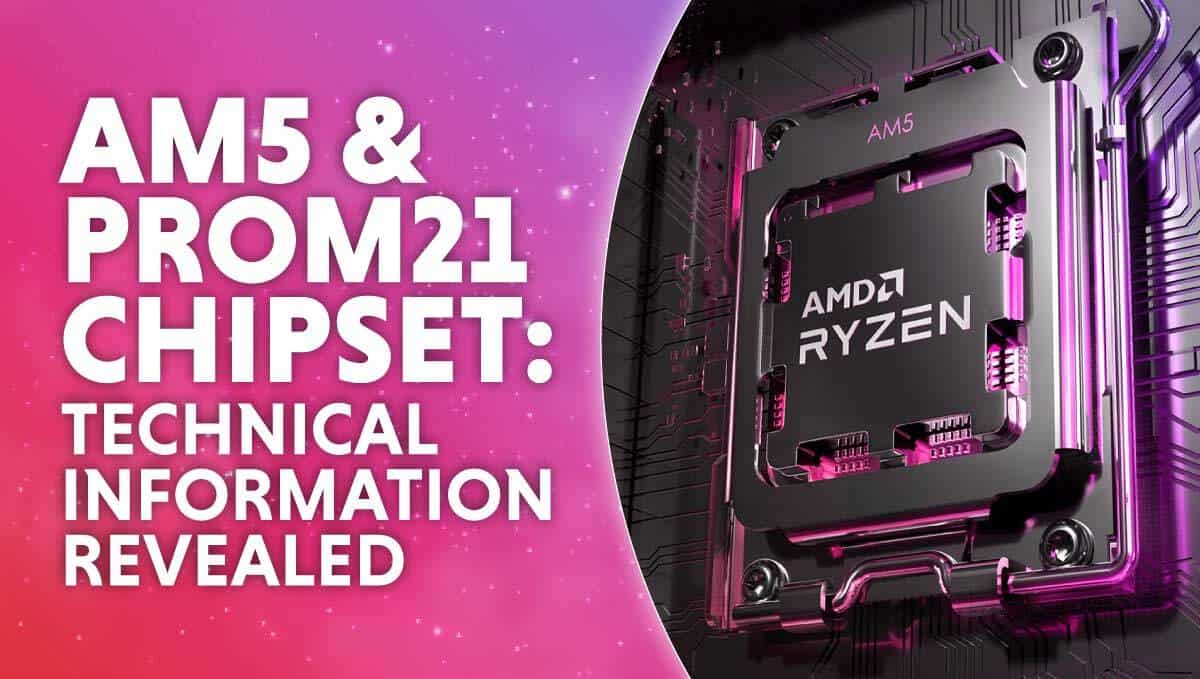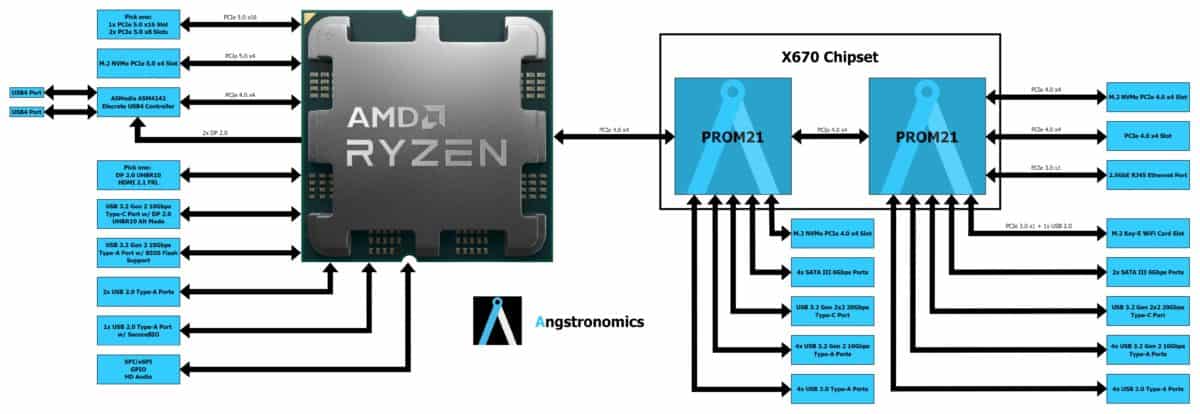AM5 & PROM21 chipset: Technical information revealed
We bring you details of AMD’s latest motherboard socket AM5 and explore how the PROM21 chipset by ASMedia is integrated into its latest socket design.

WePC is reader-supported. When you buy through links on our site, we may earn an affiliate commission. Prices subject to change. Learn more
AMD recently announced its AM5 motherboards at Computex 2022, but we’d be lying if we said we didn’t see it coming. There have been many leaks on the internet regarding AMD’s AM5 motherboards that seem to have given us more information around AM5 than AMD has divulged themselves. We hope you enjoy our AM5 & PROM21 chipset article.
The website Angstronomics has brought us some juicy information around AM5 and delved deeper into the technical aspect of AMD’s new chipset configuration.
AM5 and Promontory 21
AMD’s AM5 platform chipset was devised from the start to be designed and manufactured by a third-party supplier. This differs from the previous socket generation (AM4) as AMD repurposed their client I/O die chiplet for use as the chipset. Repurposing this die resulted in a high-cost high power chipset that was capable of PCIe Gen 4 link speeds, but it required active cooling by a very noisy cooling fan – something X570 users still complain about today.
Now, AMD has announced their PCIe Gen 5 ready chipset named Promontory 21, or ‘PROM21’ for short, will be supplied and manufactured by ASMedia. The plan was to have MediaTek in on production as well as ASMedia, but MediaTek has yet to manufacture a single chiplet for AMD.
The AMD PROM21 chipsets for AM5 come in three configurations.
- Low-end A620, with a single defeatured PROM21
- Mid-range B650, with a single PROM21
- High-end X670, with dual PROM21 chipsets on the motherboard
The low-end A-class chipset configuration will launch later than the B650 and X670 boards when the lower-tier APUs launch.
The high-end X670 chipset is unique, featuring 2 PROM21 chipsets linked in a daisy-chained configuration. The first chipset connects to the CPU as normal, and then the second chipset connects to the first chipset.
Here are the specifications of a single PROM21 chipset (B650):
- 19 x 19 mm FCBGA package
- Maximum Power ~7W
- One PCIe 4.0 x4 Uplink to host
- Two PCIe 4.0 x4 downlink controllers (Total 8 Lanes)
- Four PCIe 3.0 x1 / SATAIII 6 Gbps flexible ports (4L PCIe or 2L PCIe + 2x SATA or 4x SATA)
- Six USB 3.2 Gen 2 10 Gbps ports (Two of the ports can be fused to form one USB 3.2 Gen 2×2 20Gbps port, with four remaining 10Gbps USB ports)
- Up to 6 additional USB 2.0 ports
For the A-class chipset, one PCIe 4.0 x4 downlink is disabled.
For a typical motherboard with 4x SATA ports, the B650 variant can support one PCIe 4.0 x4 M.2 NVMe SSD, while the A-class chipset does not support any. The remaining PCIe 4.0 lanes are used for WiFi, Ethernet, and PCIe x1 expansion slots.
The X670 boards have their daisy-chained chipsets linked with PCIe 4.0 x4.
The specifications of a dual PROM21 daisy-chained board (X670) are as follows:
- Two 19 x 19 mm FCBGA packages
- Maximum Power ~7W x 2
- One PCIe 4.0 x4 Uplink to host
- Three PCIe 4.0 x4 downlink controllers (Total 12 Lanes)
- Eight PCIe 3.0 x1 / SATAIII 6 Gbps flexible ports (4L PCIe + 4x SATA or 2L PCIe + 6x SATA)
- 12 USB 3.2 Gen 2 10 Gbps ports (Four of the ports can be fused to form Two USB 3.2 Gen 2×2 20Gbps ports, with eight remaining 10Gbps USB ports)
- Up to 12 additional USB 2.0 ports
The WiFi and 2.5G Ethernet can be connected to the PCIe 3.0 lanes, freeing up all 12 lanes of PCIe 4.0 downlink for M.2 devices and PCIe slots for GPUs.
There is also plenty of I/O directly from the CPU:
- One PCIe x16 slot for graphics (or bifurcated to two x8 slots)
- One PCIe x4 slot for M.2 NVMe SSD
- One PCIe x4 link for discrete USB4 controller (Maple Ridge JHL8540 or ASMedia ASM4242) or M.2 NVMe SSD
- One PCIe 4.0 x4 for chipset downlink
- Three combo USB-C ports supporting USB3.2 Gen 2 10Gbps and DisplayPort 2.0 UHBR10 Alt Mode (each combo port can be split into discrete DP and USB 2.0 Type-A)
- One additional dedicated display output (DP 2.0 UHBR10 or HDMI 2.1 Fixed Rate Link or eDP)
- One USB 3.2 Gen 2 10Gbps port with BIOS flash capability
- One USB 2.0 port with SecureBIO support for Windows Hello capability
- SPI/eSPI, GPIO, HD Audio
“X670E“ branded motherboards will require the primary PCIe and M.2 slots to support PCIe 5.0 link rate. The chipset itself is identical to X670.
With that being said, here are the I/O block diagrams for the configuration of the B650 and X670E motherboards. These represent the best-case maximum supported configuration for each chipset variant, as lower costs and smaller form factor board designs may feature less I/O.


Advantages
Daisy-chaining chipsets are a great idea. A daisy-chained solution drastically lowers design expenses, while still allowing AMD to offer multiple instances of increased I/O and performance capabilities with one single chipset design.
Using two median chipsets is much better than designing one high-end chipset and disabling features when it’s meant for the lower-end motherboards, it’s much easier to double up for the high-end boards.
Attaching two chipsets to a motherboard has other advantages, especially over AM4. One of those advantages is that separating the load between two chipsets generates less heat, therefore the two chipsets require less cooling. This also negates the noisy active cooling issue.
The second advantage is that the first chipset acts as a signal repeater for the second chipset (when it’s set up in a daisy-chained configuration), cutting down the cost of implementing actual signal repeaters.
Disadvantages
The issue that arises with daisy-chaining chipsets together is that it drastically increases the complexity of the circuit, especially when splitting the hardware through virtualization between the two chipsets.
There’s also a second point of failure, we’ve never really heard of a chipset going down but in a complex system like this, adding another point of failure could mean issues down the road if the hardware hasn’t been properly tested.
AMD has created a very complex system here and we’re hoping that the proper measures have been taken to ensure longevity and stability within its new AM5 motherboards. AMD has been on the rise over the last four or so years, and we’d like to see that continue.











